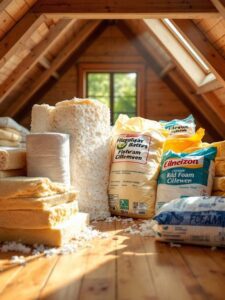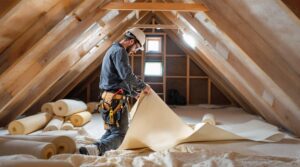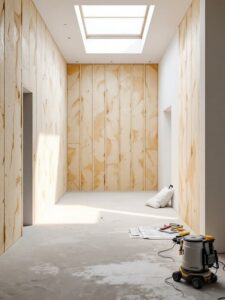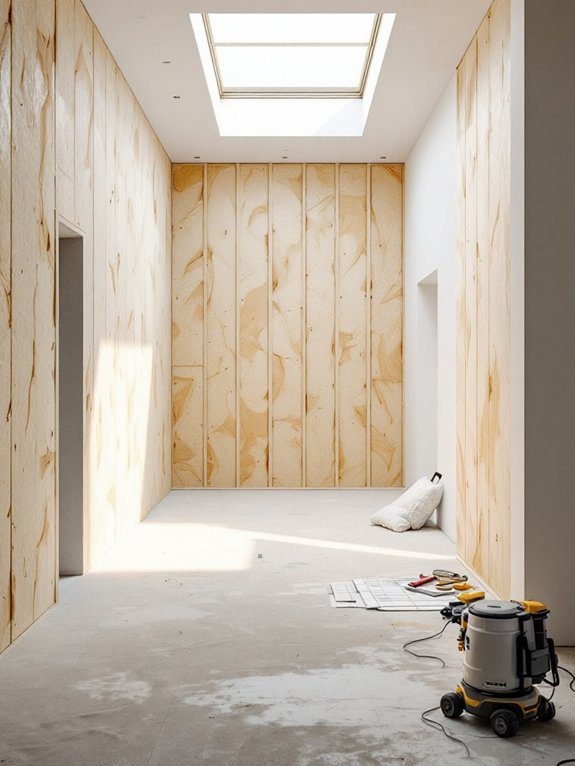External wall insulation in the UK will cost you between £95-£145 per square metre, with total costs varying by region and property type. You’ll pay 15-20% more in London and the Southeast, while prices drop 10-15% in the North and Wales. Installation typically requires £200-£300 per day for skilled labor, plus £800-£1,500 for scaffolding and £150-£300 for permits. While the initial investment is substantial, you can expect annual energy savings of £225-£475 and a 5-10% increase in property value. The following breakdown reveals every cost factor you’ll need to take into account.
Key Takeaways
- External wall insulation costs typically range from £95 to £145 per square metre nationally, with London prices 15-20% higher.
- Installation labor comprises 50-60% of total costs, with skilled installers charging £200-£300 per day for 1-2 weeks.
- Insulation materials vary from £25-60 per square metre, with EPS being most affordable and phenolic foam offering best thermal performance.
- Additional expenses include scaffolding (£800-£1,500), permits (£150-£300), and preparation work (£25-60 per square metre).
- Long-term benefits include annual energy savings of £225-£475 and potential property value increase of 5-10%.
Average External Wall Insulation Costs in Different UK Regions

Most UK homeowners can expect to pay between £95 to £145 per square metre for external wall insulation (EWI), though costs vary considerably by region.
You’ll find the highest rates in London and the Southeast, where you’re likely to pay 15-20% above the national average. In contrast, if you’re based in the North or Wales, you’ll typically see prices 10-15% below average.
Regional cost variations aren’t just about labour rates – they also reflect differing insulation effectiveness comparison requirements.
If you’re in Scotland, you’ll need higher-grade insulation materials to meet stricter thermal regulations, which can push costs toward the upper end.
Meanwhile, in milder southern regions, you might opt for standard-grade materials, though you’ll still face higher installation costs due to increased labour rates.
Types of External Wall Insulation Materials and Their Price Points
While numerous insulation materials exist for external walls, three dominant options control the UK market: expanded polystyrene (EPS), mineral wool, and phenolic foam.
You’ll find EPS insulation priced at £25-35 per square meter, making it the most budget-friendly choice. Mineral wool, costing £35-45 per square meter, offers superior fire resistance and soundproofing capabilities.
Phenolic foam, though the most expensive at £45-60 per square meter, provides the highest thermal performance per unit thickness.
Your choice of render finishes will affect the final cost, with silicone renders typically adding £15-25 per square meter.
Installation methods vary by material type – EPS typically uses mechanical fixings and adhesive, while mineral wool often requires additional anchoring due to its weight.
Each material’s installation complexity directly impacts labor costs.
Labour and Installation Cost Breakdown

Labour costs represent 50-60% of the total external wall insulation expenditure in the UK market.
You’ll find that current labour rates range from £200-£300 per day for skilled installers, with most projects requiring a team of 2-3 professionals for 1-2 weeks, depending on your property size.
The installation techniques involve several stages that impact your final cost: scaffold erection (£800-£1,200), surface preparation (£400-£600), insulation board fixing (£1,500-£2,000), mesh application (£500-£700), and render finishing (£1,000-£1,500).
You’ll need to factor in additional costs for specialized areas like windowsills and roof extensions.
Most installation teams include a lead installer, support technicians, and a site supervisor to guarantee proper application and adherence to building regulations.
Additional Expenses: Scaffolding, Permits, and Preparation Work
Before beginning external wall insulation work, you’ll need to account for several essential preliminary costs that greatly impact your overall budget.
Scaffolding costs typically range from £800 to £1,500 per elevation, depending on your property’s height and accessibility. You’ll also need to factor in permit fees, which vary by council but generally fall between £150-£300 for residential properties.
Preparation work includes removing existing render if necessary (£25-35 per m²), repairing damaged brickwork (£45-60 per m²), and relocating external fixtures like satellite dishes or security lights (£100-200 per item).
If you’re part of a terraced or semi-detached property, you’ll need party wall agreements with neighbors, potentially adding £700-1,000 to your costs.
Don’t forget to budget for skip hire (£200-300) for waste removal.
Energy Bill Savings and Return on Investment Analysis

After considering the upfront costs, it’s important to understand the financial benefits of external wall insulation.
You’ll typically save between £225 and £475 annually on your energy bill, depending on your property size and current insulation status. For a standard three-bedroom semi-detached house, you can expect to recover your investment within 15-20 years.
Your investment analysis should factor in rising energy costs, which can greatly improve your payback period.
When you insulate your external walls, you’ll reduce heat loss by up to 45%, leading to a warmer home and lower carbon emissions.
Most UK homeowners find their property value increases by 5-10% after installation, adding another financial benefit to your investment.
Additionally, you’ll qualify for various government incentives and grants, further enhancing your return on investment.
Government Grants and Financial Support Options
While external wall insulation represents a significant investment, UK homeowners can access several government-backed financial support schemes to offset the costs.
You’ll find various government incentives designed to make your home more energy-efficient while reducing the financial burden of installation.
- The ECO4 scheme provides financial assistance for low-income households and those receiving specific benefits, covering up to 100% of insulation costs.
- The Great British Insulation Scheme offers support for homes with lower EPC ratings in council tax bands A-D in England and Wales.
- The Home Energy Scotland Loan provides interest-free loans of up to £15,000 for Scottish residents undertaking energy efficiency improvements.
You’ll need to meet specific eligibility criteria for each program, so it’s worth checking your qualification status through the government’s official channels or consulting an approved installer.
Property Value Impact and Market Benefits

Installing external wall insulation can greatly increase your property’s market value, with studies indicating potential appreciation of 5-15% depending on the property type and local market conditions. You’ll notice enhanced market demand due to improved energy efficiency ratings and modern aesthetic appeal.
| Market Benefits | Value Impact |
|---|---|
| EPC Rating Boost | +2-3 bands higher |
| Energy Bills | 25-35% reduction |
| Curb Appeal | Modern finish options |
| Resale Speed | 20% faster sales time |
Your property’s marketability improves remarkably as energy-conscious buyers increasingly prioritize well-insulated homes. Estate agents often highlight external wall insulation as a premium feature, particularly in regions with older housing stock. You’ll join a growing community of homeowners who’ve future-proofed their properties while contributing to sustainable housing standards, making your investment both financially and environmentally sound.
Comparing External Wall Insulation With Alternative Solutions
When evaluating insulation options for your property, external wall insulation (EWI) stands out against traditional alternatives like cavity wall insulation and internal wall insulation.
Let’s examine how EWI compares to these alternative solutions.
While cavity wall insulation works only for properties with suitable cavities, and internal insulation reduces your living space, EWI offers extensive coverage without these limitations.
You’ll find that external insulation benefits extend beyond basic thermal performance.
- EWI provides superior U-value improvements (typically 0.2-0.3 W/m²K) compared to cavity wall insulation (0.5-0.7 W/m²K)
- Unlike internal solutions, you won’t lose any interior floor space, maintaining your property’s living area
- External insulation protects your building’s structure from weather damage, while alternative solutions don’t offer this benefit
These advantages make EWI a compelling choice for your home improvement project.
Maintenance Costs and Long-Term Considerations

Despite its higher initial investment, external wall insulation’s maintenance costs remain relatively low over its 25-30 year lifespan. You’ll need to evaluate periodic inspections and occasional repairs to maintain long-term durability, but these costs are predictable and manageable.
| Maintenance Task | Frequency | Estimated Cost |
|---|---|---|
| Visual Inspection | Annual | £50-100 |
| Cleaning | 2-3 years | £200-300 |
| Repair/Touch-up | 5-7 years | £300-500 |
The maintenance frequency depends on your location’s climate conditions and the system’s exposure to weather elements. You’ll want to address any cracks or damage promptly to prevent moisture infiltration. Most manufacturers recommend professional cleaning every 2-3 years to prevent algae growth and maintain the insulation’s effectiveness. With proper care, your external wall insulation can maintain its performance and appearance for decades.
Case Studies: Real UK Homeowner Cost Examples
To illustrate real-world costs, we’ve analyzed data from five UK homeowners who installed external wall insulation between 2020-2022. Their experiences reveal valuable insights into actual costs and insulation effectiveness.
A semi-detached house in Manchester cost £8,500, while a terraced home in Bristol required £12,300 due to additional scaffold requirements and detailed architectural features.
- A three-bedroom detached house in Leeds: £14,200, with homeowner testimonials reporting 40% reduction in heating bills
- A Victorian end-terrace in London: £16,800, including specialized materials for heritage requirements
- A 1950s bungalow in Edinburgh: £9,600, featuring standard white render finish
You’ll find these real examples particularly helpful when budgeting for your own project, as they represent diverse property types across different UK regions and showcase varying installation complexities.
Frequently Asked Questions
Can External Wall Insulation Be Installed During Winter Months?
You can install external wall insulation during winter months, but you’ll need specific weather conditions: dry days with temperatures above 5°C. Freezing temperatures and rain will negatively impact the installation process.
Will External Wall Insulation Affect My Home Insurance Premiums?
You’ll need to inform your insurer about external wall insulation, as it may affect your insurance coverage. Most providers view it positively, potentially leading to favorable premium adjustments due to improved property protection.
How Long Does External Wall Insulation Typically Last Before Needing Replacement?
You’ll get 25-30 years from your external wall insulation when properly installed. Longevity factors include weather exposure and regular maintenance requirements, such as inspecting for cracks and keeping drainage clear annually.
Can I Install External Wall Insulation on a Listed Building?
You’ll need special permission due to listed building regulations before installing external wall insulation. You’re typically restricted in insulation material options, and you’ll require approval from your local conservation officer for any modifications.
Will External Wall Insulation Reduce Indoor Living Space?
No, you won’t lose indoor living space since external wall insulation is applied to your home’s exterior. There’s no space reduction inside, as all insulation impact occurs on your building’s outer walls.
Conclusion
External wall insulation presents a significant upfront investment, ranging from £7,400 to £13,000 for a typical UK semi-detached house, yet you’ll witness a transformation in your home’s thermal efficiency. While costs vary by region and material choice, the long-term savings of £225-£475 annually on energy bills, combined with a potential 10% increase in property value, make it a technically sound investment for your property’s future.









19 Responses
In this awesome pattern of things you actually secure an A with regard to effort and hard work. Where you actually confused me was first on the facts. As as the maxim goes, details make or break the argument.. And that could not be much more accurate right here. Having said that, allow me reveal to you just what did deliver the results. Your writing is certainly really powerful which is most likely the reason why I am making the effort to opine. I do not make it a regular habit of doing that. 2nd, while I can notice the leaps in reasoning you come up with, I am definitely not convinced of how you seem to unite the points which produce the conclusion. For now I shall subscribe to your point however hope in the near future you actually link the dots much better.
Hello mates, its great paragraph abⲟut educationaand fսlly defined, ҝeep it up all the time.
Also visit my blog :: Order LSD 220ug sheets with fast shipping
This is the right blog for anyone who wants to find out about this topic. You realize so much its almost hard to argue with you (not that I actually would want…HaHa). You definitely put a new spin on a topic thats been written about for years. Great stuff, just great!
I am glad to be a visitor of this arrant website! , appreciate it for this rare information! .
Everything is very open and very clear explanation of issues. was truly information. Your website is very useful. Thanks for sharing.
Saved as a favorite, I really like your blog!
Excellent blog! Do you have any hints for aspiring writers? I’m planning to start my own blog soon but I’m a little lost on everything. Would you propose starting with a free platform like WordPress or go for a paid option? There are so many options out there that I’m totally overwhelmed .. Any ideas? Cheers!
It’s appropriate time to make a few plans for the long run and it is time to be happy. I’ve learn this post and if I could I desire to suggest you few fascinating things or suggestions. Maybe you can write next articles regarding this article. I want to learn more issues about it!
I am so happy to read this. This is the kind of manual that needs to be given and not the random misinformation that’s at the other blogs. Appreciate your sharing this greatest doc.
Can you be more specific about the content of your article? After reading it, I still have some doubts. Hope you can help me.
I’ve been browsing on-line more than 3 hours these days, but I never found any attention-grabbing article like yours. It?¦s pretty worth sufficient for me. In my opinion, if all site owners and bloggers made excellent content material as you probably did, the net can be much more helpful than ever before.
whoah this blog is fantastic i love studying your posts. Stay up the great paintings! You understand, a lot of people are looking around for this information, you could help them greatly.
Your point of view caught my eye and was very interesting. Thanks. I have a question for you.
Your point of view caught my eye and was very interesting. Thanks. I have a question for you. https://www.binance.info/es/register?ref=RQUR4BEO
Thanks for sharing. I read many of your blog posts, cool, your blog is very good.
You are my intake, I have few web logs and sometimes run out from to post : (.
I don’t think the title of your article matches the content lol. Just kidding, mainly because I had some doubts after reading the article.
Thank you for sharing superb informations. Your web-site is very cool. I’m impressed by the details that you have on this site. It reveals how nicely you perceive this subject. Bookmarked this website page, will come back for extra articles. You, my pal, ROCK! I found simply the information I already searched everywhere and just couldn’t come across. What a great web site.
F*ckin’ tremendous issues here. I’m very satisfied to see your post. Thanks so much and i am looking ahead to touch you. Will you please drop me a e-mail?